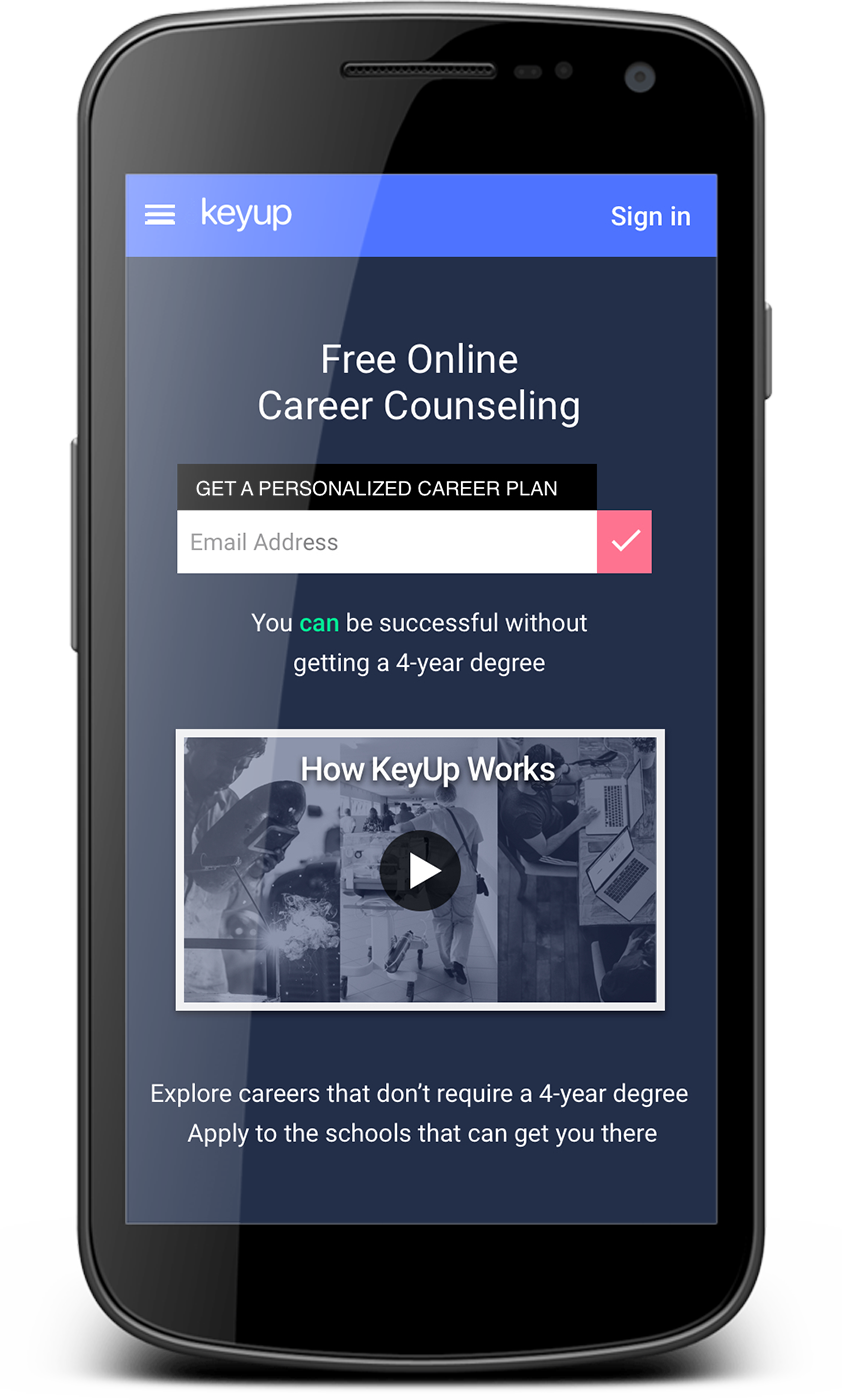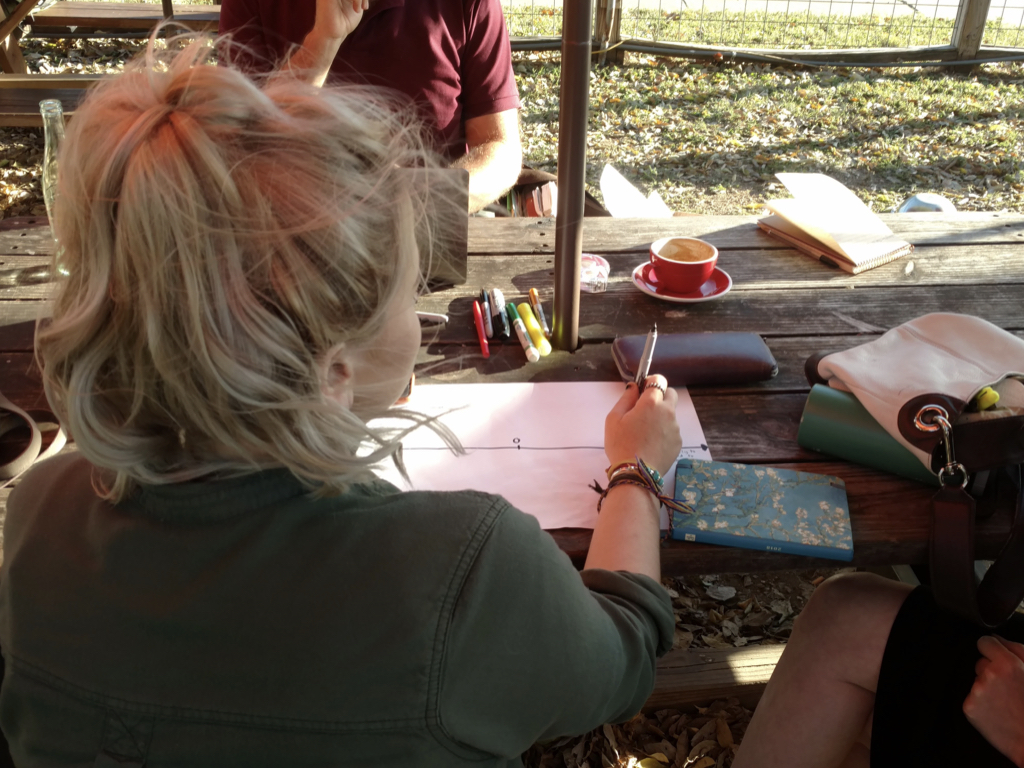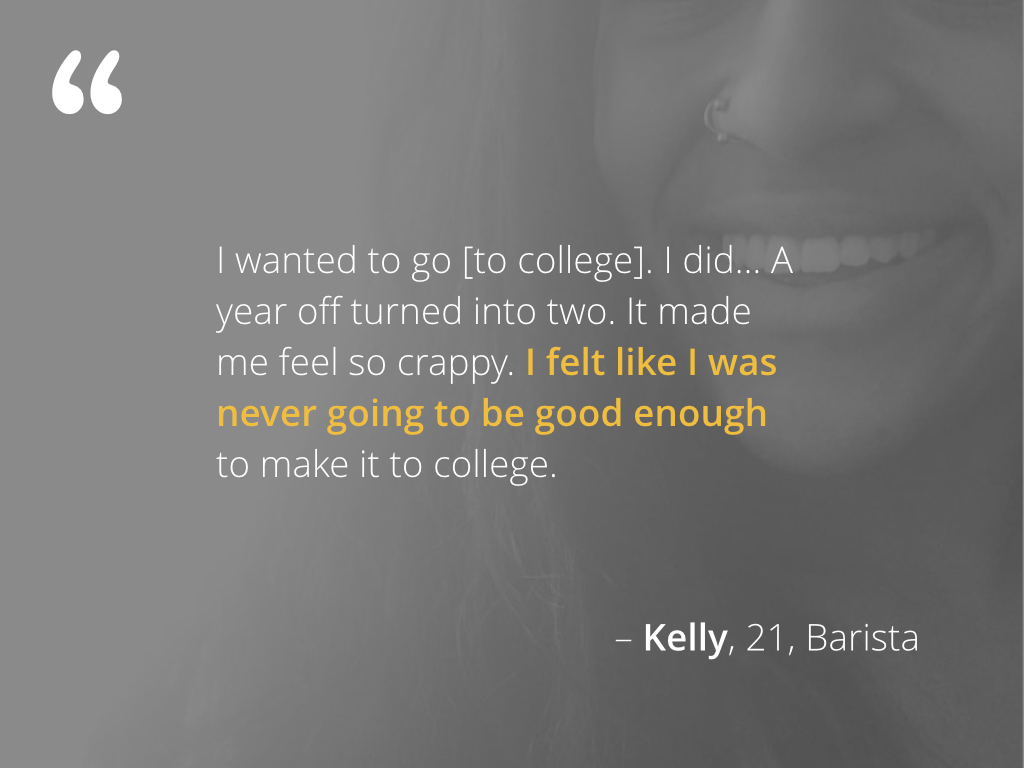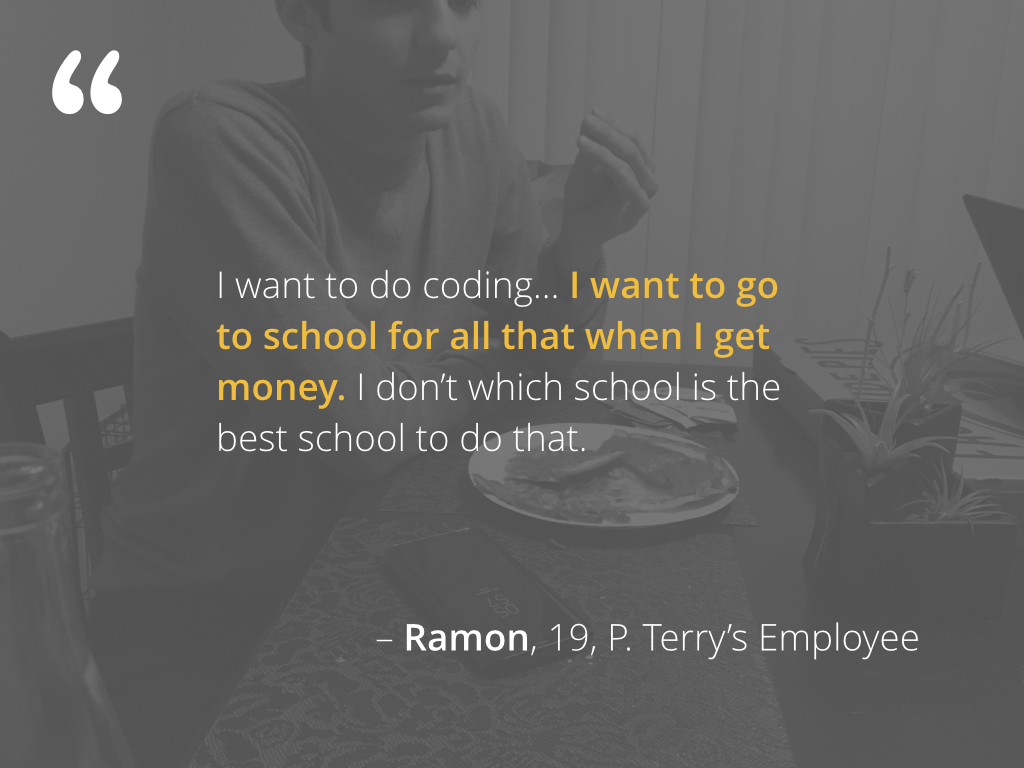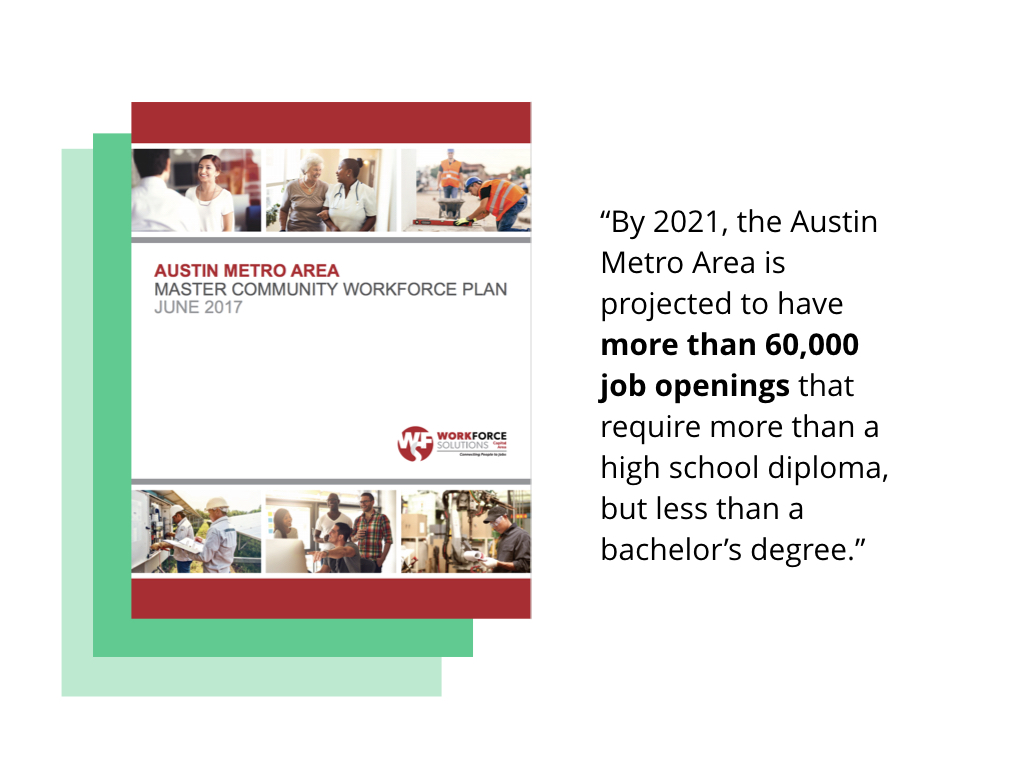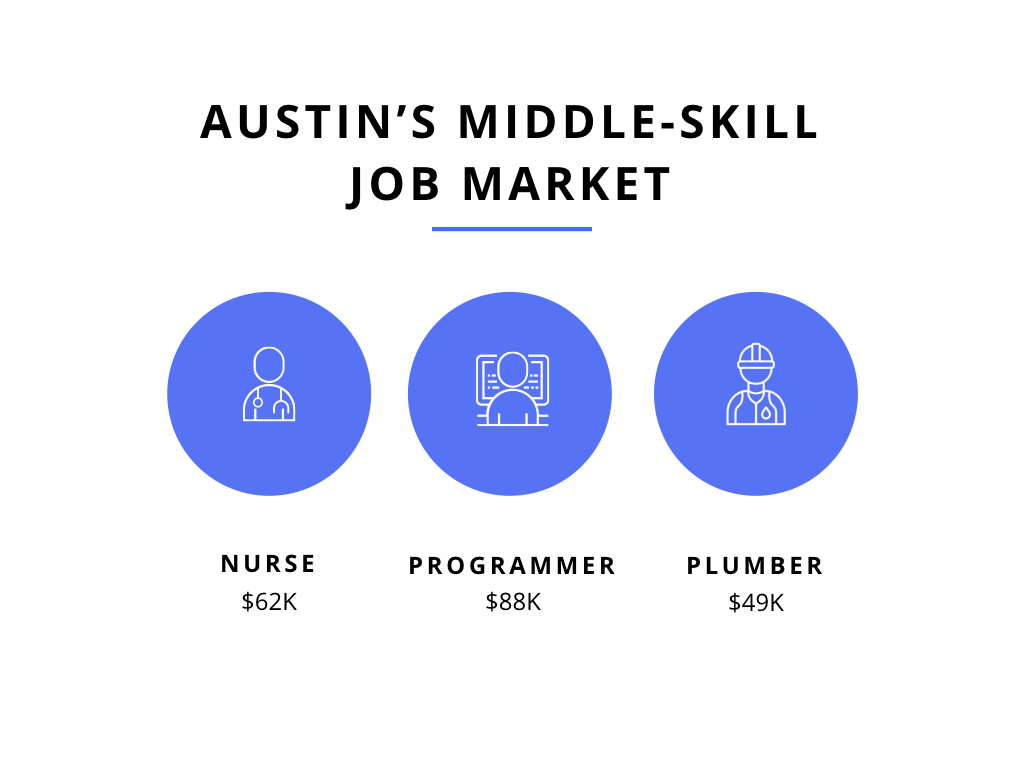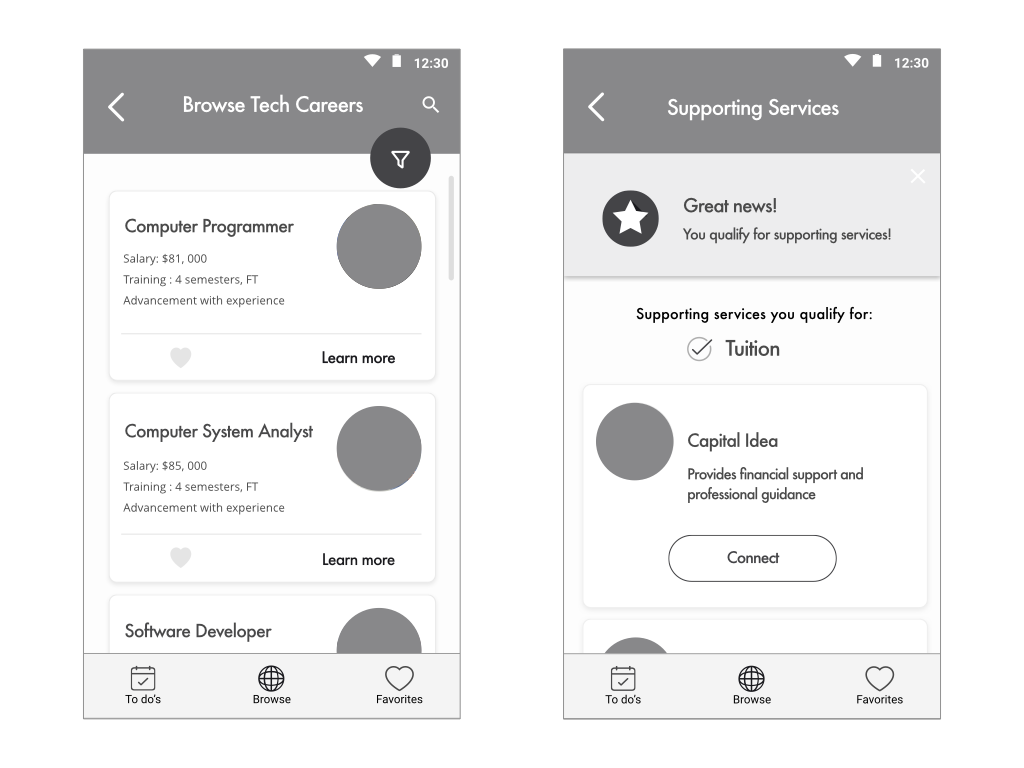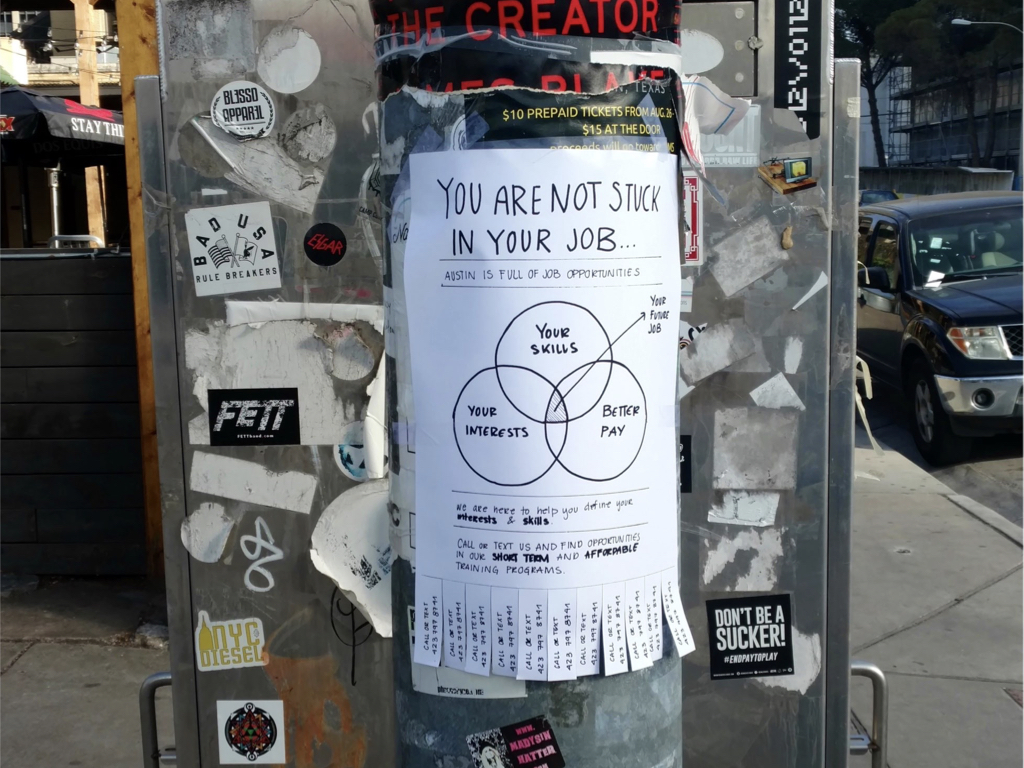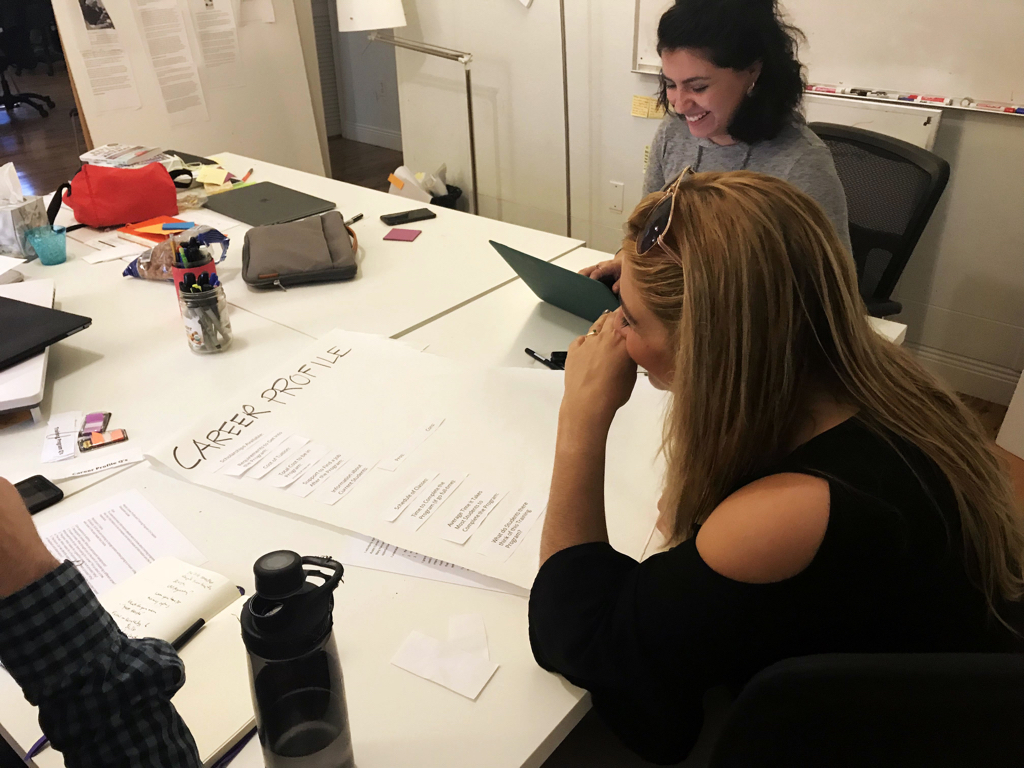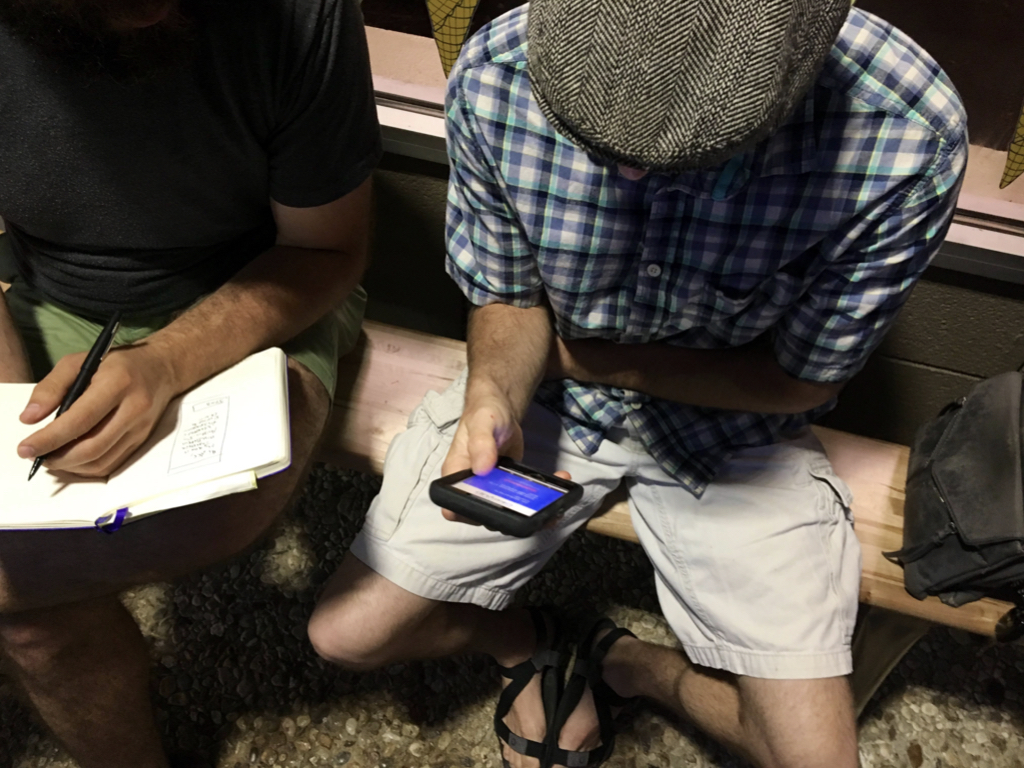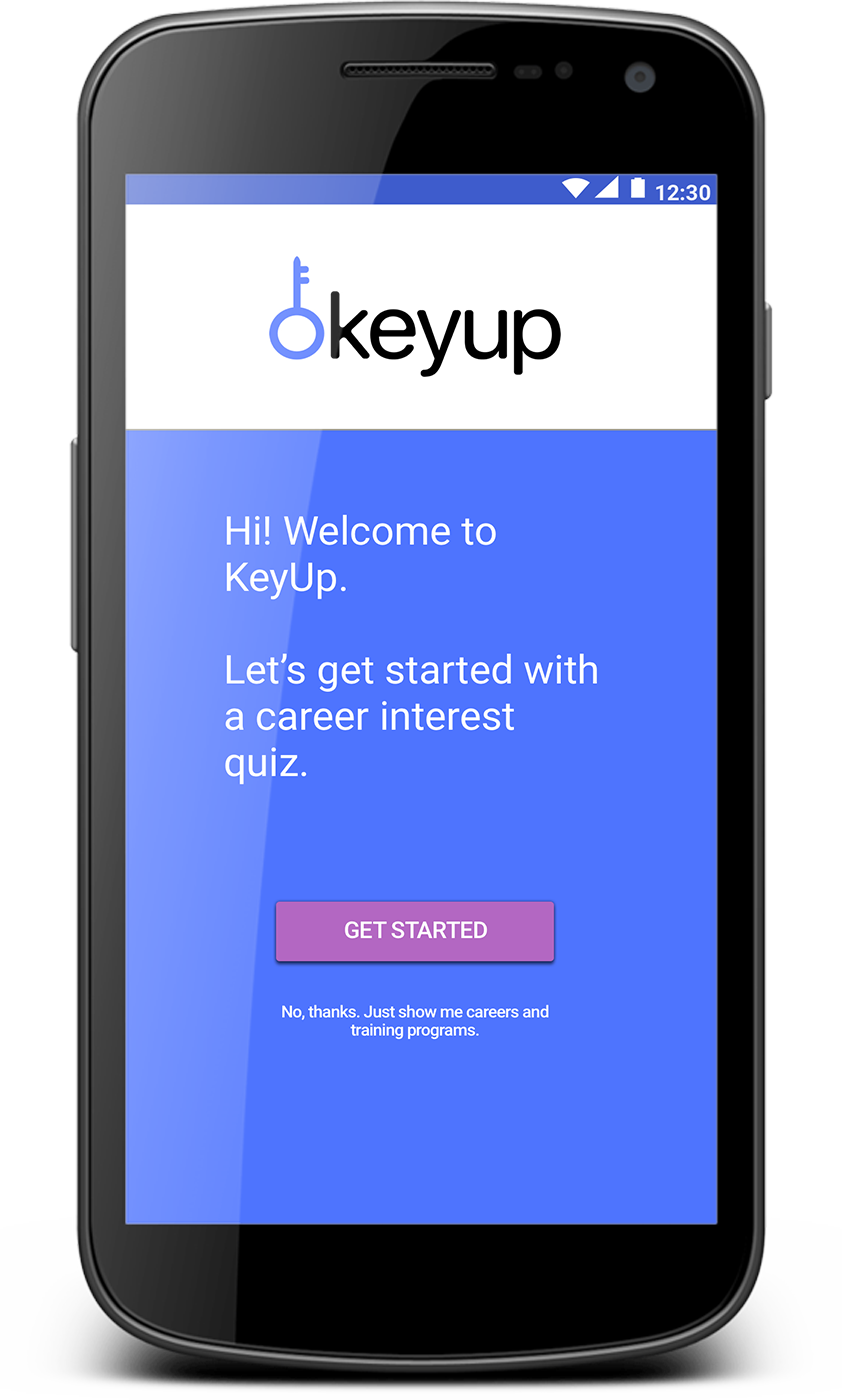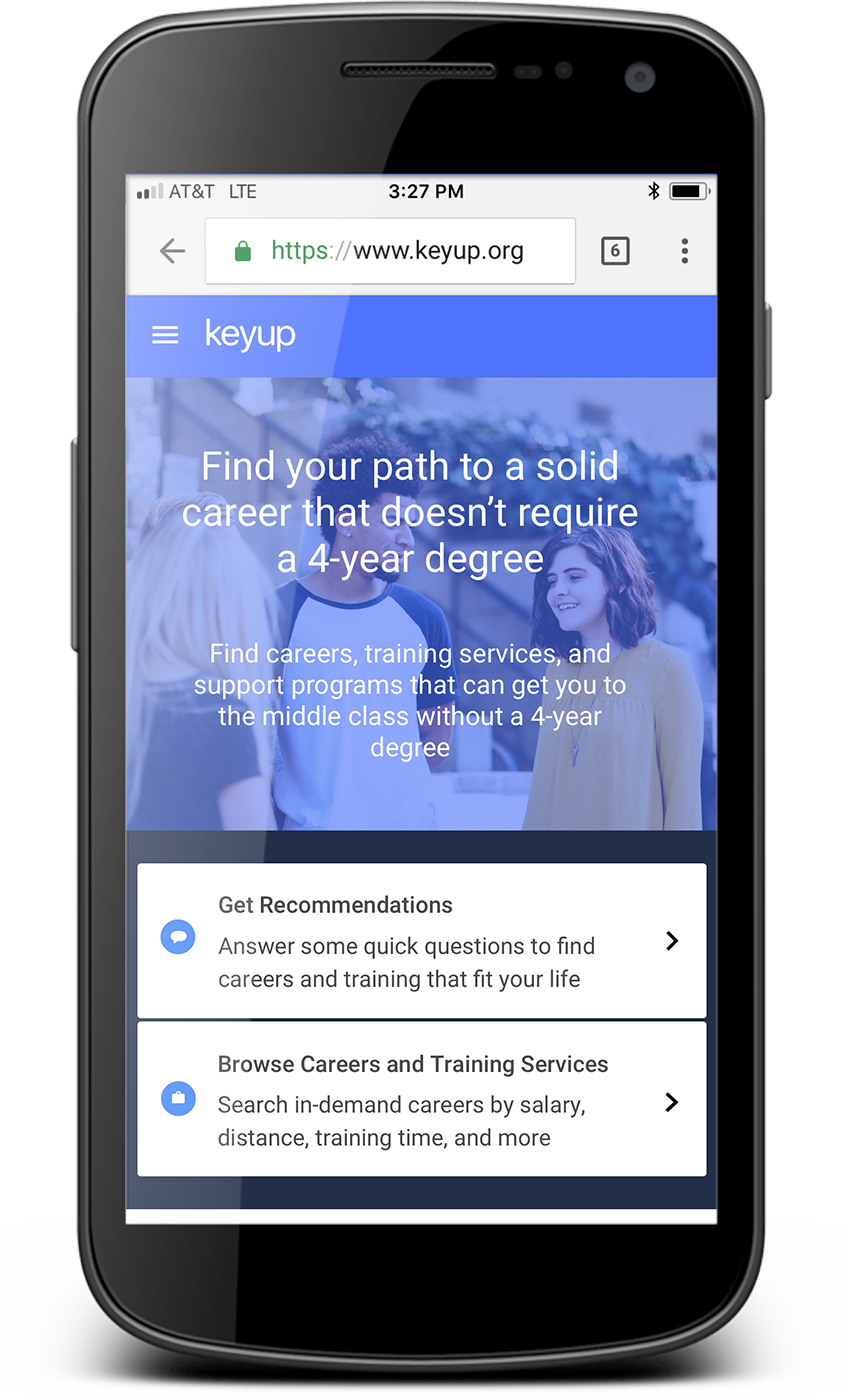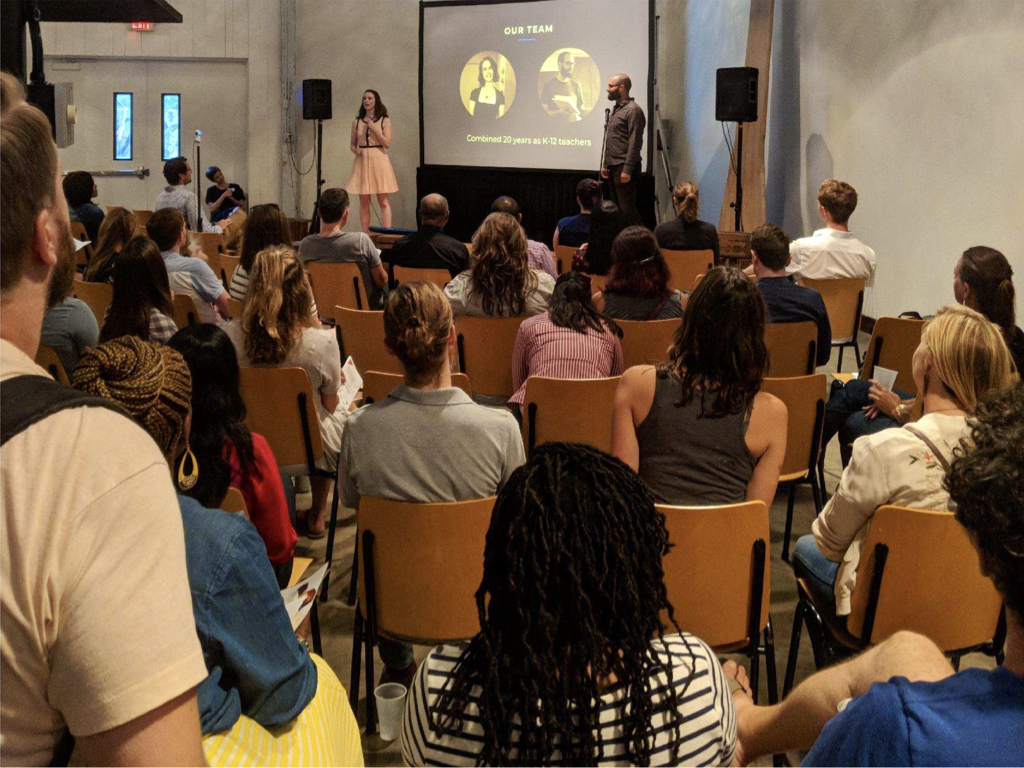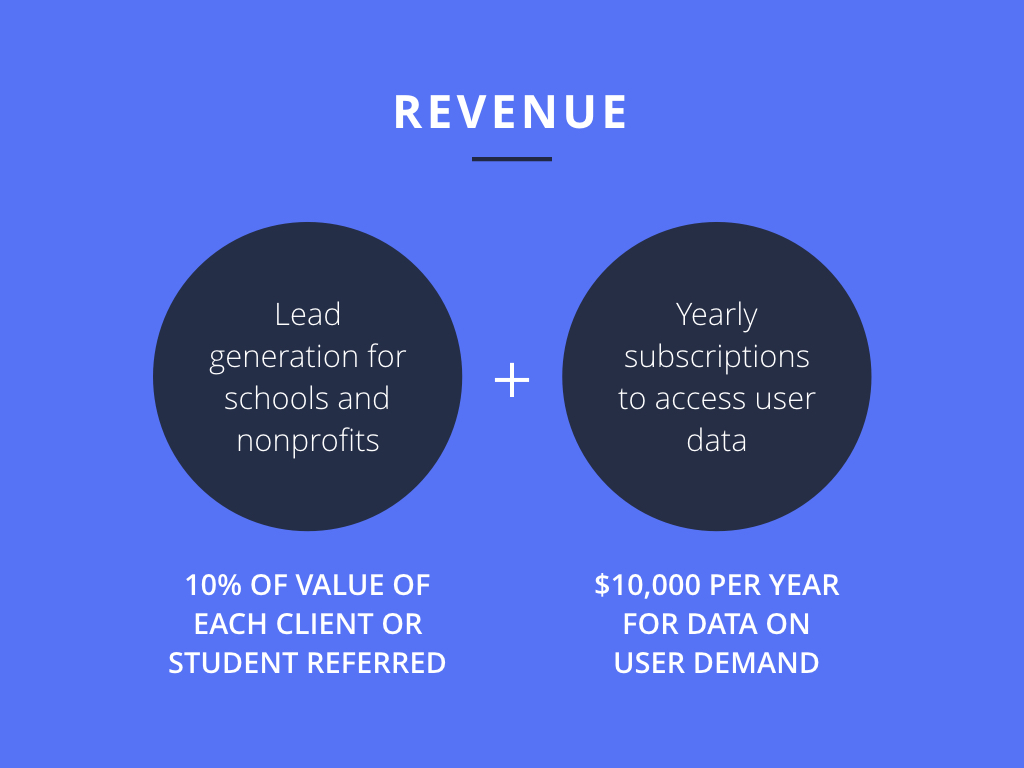KeyUp
KeyUp
Co-founding a startup to enable people to reach the middle class without getting a bachelor's degree
Co-founding a startup to enable people to reach the middle class without getting a bachelor's degree
Co-founding a startup to enable people to reach the middle class without getting a bachelor's degree
Co-founding a startup to enable people to reach the middle class without getting a bachelor's degree
The KeyUp homepage. This wireframe and all other artifacts included in this case study were created by me unless they are otherwise credited.
An early digital version of KeyUp's home page that prioritized gathering information from users in order to give out personalized advice.
An early digital version of KeyUp's home page that prioritized gathering information from users in order to give out personalized advice.
An early digital version of KeyUp's home page that prioritized gathering information from users in order to give out personalized advice.
An early digital version of KeyUp's home page that prioritized gathering information from users in order to give out personalized advice.
SUMMARY
SUMMARY
SUMMARY
The American education system is designed to funnel people into 4-year colleges. However, most Americans either never start college or do not finish their degrees. As a result, if college doesn’t work out, people looking to upskill into higher-paying careers don’t know how else to reach financial security.
People in low-paying jobs need a one-stop shop to find paths to secure careers other than attending a 4-year college.
So, we created KeyUp.
The American education system is designed to funnel people into 4-year colleges. However, most Americans either never start college or do not finish their degrees. As a result, if college doesn’t work out, people looking to upskill into higher-paying careers don’t know how else to reach financial security.
People in low-paying jobs need a one-stop shop to find paths to secure careers other than attending a 4-year college.
So, we created KeyUp.
The American education system is designed to funnel people into 4-year colleges. However, most Americans either never start college or do not finish their degrees. As a result, if college doesn’t work out, people looking to upskill into higher-paying careers don’t know how else to reach financial security.
People in low-paying jobs need a one-stop shop to find paths to secure careers other than attending a 4-year college.
So, we created KeyUp.
The American education system is designed to funnel people into 4-year colleges. However, most Americans either never start college or do not finish their degrees. As a result, if college doesn’t work out, people looking to upskill into higher-paying careers don’t know how else to reach financial security.
People in low-paying jobs need a one-stop shop to find paths to secure careers other than attending a 4-year college.
So, we created KeyUp.
MY ROLE
MY ROLE
MY ROLE
Co-founder
Chief operating officer
Product manager
Design researcher
UX designer
Co-Founder
Chief Operating Officer
Product Manager
Design Researcher
UX Designer
Co-Founder
Chief Operating Officer
Product Manager
Design Researcher
UX Designer
Co-Founder
Chief Operating Officer
Product Manager
Design Researcher
UX Designer
TIMELINE
TIMELINE
TIMELINE
October 2017 - December 2018
Co-Founder
Chief Operating Officer
Product Manager
Design Researcher
UX Designer
October 2017 - December 2018
October 2017 - December 2018
Research
Research
Research
Combining contextual inquiries with secondary research to build empathy with young adults without 4-year degrees
Combining contextual inquiries with secondary research to build empathy with young adults without 4-year degrees
Combining contextual inquiries with secondary research to build empathy with young adults without 4-year degrees
The genesis of KeyUp was a brief from the City of Austin Innovation Office to look at civic engagement among underrepresented populations. To that end, we set out to better understand the experiences of young adults in Austin without 4-year degrees.
Our research plan included ethnographic and secondary research techniques, including immersions, contextual inquiries, intercept interviews, and co-creation activities. We ultimately interviewed 88 young adults and 25 subject matter experts (SMEs) to build a picture of the lives of 18-25 year olds working as HEB cart pushers, baristas, and Uber drivers.
The genesis of KeyUp was a brief from the City of Austin Innovation Office to look at civic engagement among underrepresented populations. To that end, we set out to better understand the experiences of young adults in Austin without 4-year degrees.
Our research plan included ethnographic and secondary research techniques, including immersions, contextual inquiries, and co-creation activities. We ultimately interviewed 88 young adults and 25 subject matter experts (SMEs) to build a picture of the lives of 18-25 year olds working as HEB cart pushers, baristas, and Uber drivers.
The genesis of KeyUp was a brief from the City of Austin Innovation Office to look at civic engagement among underrepresented populations. To that end, we set out to better understand the experiences of young adults in Austin without 4-year degrees.
Our research plan included ethnographic and secondary research techniques, including immersions, contextual inquiries, and co-creation activities. We ultimately interviewed 88 young adults and 25 subject matter experts (SMEs) to build a picture of the lives of 18-25 year olds working as HEB cart pushers, baristas, and Uber drivers.
The genesis of KeyUp was a brief from the City of Austin Innovation Office to look at civic engagement among underrepresented populations. To that end, we set out to better understand the experiences of young adults in Austin without 4-year degrees.
Our research plan included ethnographic and secondary research techniques, including immersions, contextual inquiries, and co-creation activities. We ultimately interviewed 88 young adults and 25 subject matter experts (SMEs) to build a picture of the lives of 18-25 year olds working as HEB cart pushers, baristas, and Uber drivers.
The genesis of KeyUp was a brief from the City of Austin Innovation Office to look at civic engagement among underrepresented populations. To that end, we set out to better understand the experiences of young adults in Austin without 4-year degrees.
Our research plan included ethnographic and secondary research techniques, including immersions, contextual inquiries, and co-creation activities. We ultimately interviewed 88 young adults and 25 subject matter experts (SMEs) to build a picture of the lives of 18-25 year olds working as HEB cart pushers, baristas, and Uber drivers.
Synthesis
Synthesis
Synthesis
Distilling clarity from complexity
Distilling clarity from complexity
Distilling clarity from complexity
After completing our generative research sessions, we sat with the data and walked away with these insights about the experiences of young adults without 4-year degrees:
- Americans are trained to believe there’s only one path to the middle class: a 4-year degree or bust.
After completing our generative research sessions, we sat with the data and walked away with these insights about the experiences of young adults without 4-year degrees:
- Americans are trained to believe there’s only one path to the middle class: a 4-year degree or bust.
After completing our generative research sessions, we sat with the data and walked away with these insights about the experiences of young adults without 4-year degrees:
- Americans are trained to believe there’s only one path to the middle class: a 4-year degree or bust.
- Though almost half of students who enter college will not finish their degree in 6 years, people who drop out feel a paralyzing shame about leaving school.
- Though almost half of students who enter college will not finish their degree in 6 years, people who drop out feel a paralyzing shame about leaving school.
- Though almost half of students who enter college will not finish their degree in 6 years, people who drop out feel a paralyzing shame about leaving school.
- When young adults do try to look for other opportunities after leaving college, their career options are limited to what is familiar to people in their social networks.
- When young adults do try to look for other opportunities after leaving college, their career options are circumscribed by the knowledge base of their social networks.
- When young adults do try to look for other opportunities after leaving college, their career options are circumscribed by the knowledge base of their social networks.
Taken together, these circumstances lead low-income young adults without 4-year degrees to feel trapped in low-wage jobs.
Taken together, these circumstances lead low-income young adults without 4-year degrees to feel trapped in low-wage jobs.
Taken together, these circumstances lead low-income young adults without 4-year degrees to feel trapped in low-wage jobs.
Taken together, these circumstances lead low-income young adults without 4-year degrees to feel trapped in low-wage jobs.
Taken together, these circumstances lead low-income young adults without 4-year degrees to feel trapped in low-wage jobs.
Ideation
Ideation
Ideation
Addressing wicked problems with abductive thinking
Addressing wicked problems with abductive thinking
Addressing wicked problems with abductive thinking
Though our research yielded findings about the civic engagement of young people (see Chapter 4 of Civic Health of Economically Disadvantaged Residents in Austin), our research also showed that the young people we had met did not have the bandwidth to engage civically. Just getting by demanded too much of their attention. We decided to focus on that job-to-be-done: how best to help young people without 4-year degrees achieve financial security.
Zooming out to look at the larger postsecondary and employment environment, our secondary research and interviews with SMEs demonstrated that though 4-year colleges are great paths for many people, they are not the only way to reach the middle class.
The problem is that the current education pipeline does not support people seeking good-paying, “middle-skill” careers.
Though our research yielded findings about the civic engagement of young people (see Chapter 4 of Civic Health of Economically Disadvantaged Residents in Austin), our research also showed that the young people we had met did not have the bandwidth to engage civically. Just getting by demanded too much of their attention. We decided to focus on that job-to-be-done: how best to help young people without 4-year degrees achieve financial security.
Zooming out to look at the larger postsecondary and employment environment, our secondary research and interviews with SMEs demonstrated that though 4-year colleges are great paths for many people, they are not the only way to reach the middle class. The problem is that the current education pipeline is not set up to support people seeking these “middle-skill” careers.
Though our research yielded findings about the civic engagement of young people (see Chapter 4 of Civic Health of Economically Disadvantaged Residents in Austin), our research also showed that the young people we had met did not have the bandwidth to engage civically. Just getting by demanded too much of their attention. We decided to focus on that job-to-be-done: how best to help young people without 4-year degrees achieve financial security.
Zooming out to look at the larger postsecondary and employment environment, our secondary research and interviews with SMEs demonstrated that though 4-year colleges are great paths for many people, they are not the only way to reach the middle class. The problem is that the current education pipeline is not set up to support people seeking these “middle-skill” careers.
Though our research yielded findings about the civic engagement of young people (see Chapter 4 of Civic Health of Economically Disadvantaged Residents in Austin), our research also showed that the young people we had met did not have the bandwidth to engage civically. Just getting by demanded too much of their attention. We decided to focus on that job-to-be-done: how best to help young people without 4-year degrees achieve financial security.
Zooming out to look at the larger postsecondary and employment environment, our secondary research and interviews with SMEs demonstrated that though 4-year colleges are great paths for many people, they are not the only way to reach the middle class. The problem is that the current education pipeline is not set up to support people seeking these “middle-skill” careers.
A major barrier to reaching middle-skill careers is that there’s no one-stop shop where people can learn about careers that don’t require a 4-year degree and the training services and support programs that can get them there. That’s why we created KeyUp.
In short, there’s no one-stop shop where people can learn about careers that don’t require a 4-year degree and the training services and support programs that can get them there. That’s why we created KeyUp.
In short, there’s no one-stop shop where people can learn about careers that don’t require a 4-year degree and the training services and support programs that can get them there. That’s why we created KeyUp.
The Concept
The Concept
The Concept
KeyUp exists to create a world in which low-income young adults have paths to the middle class other than attending a 4-year college
KeyUp exists to create a world in which low-income young adults have paths to the middle class other than attending a 4-year college
KeyUp exists to create a world in which low-income young adults have paths to the middle class other than attending a 4-year college
KeyUp puts all the pieces together in one place; it enables users to explore middle-skill careers and compare and apply for the training services and support programs in Austin that can get them to those careers.
KeyUp puts all the pieces together in one place; it enables users to explore middle-skill careers and compare and apply for the training services and support programs in Austin that can get them to those careers.
KeyUp puts all the pieces together in one place; it enables users to explore middle-skill careers and compare and apply for the training services and support programs in Austin that can get them to those careers.
KeyUp puts all the pieces together in one place; it enables users to explore middle-skill careers and compare and apply for the training services and support programs in Austin that can get them to those careers.
Rough wireframes created by collaborator Mariangela Marin to communicate the idea of KeyUp.
An early digital version of KeyUp's home page that prioritized gathering information from users in order to give out personalized advice.
An early digital version of KeyUp's home page that prioritized gathering information from users in order to give out personalized advice.
An early digital version of KeyUp's home page that prioritized gathering information from users in order to give out personalized advice.
An early digital version of KeyUp's home page that prioritized gathering information from users in order to give out personalized advice.
A sitemap I created to convey KeyUp's MVP organization and hierarchy
An early digital version of KeyUp's home page that prioritized gathering information from users in order to give out personalized advice.
An early digital version of KeyUp's home page that prioritized gathering information from users in order to give out personalized advice.
An early digital version of KeyUp's home page that prioritized gathering information from users in order to give out personalized advice.
An early digital version of KeyUp's home page that prioritized gathering information from users in order to give out personalized advice.
Development and Iteration
Development and Iteration
Development and Iteration
Testing, increasing levels of fidelity, and making KeyUp better
Testing, increasing levels of fidelity, and making KeyUp better
Testing, increasing levels of fidelity, and making KeyUp better
To make sure that KeyUp would actually align with user needs and mental models, we conducted co-creation sessions with our target users and tested out prototypes in increasing levels of fidelity, from hand-drawn posters all the way to high-fidelity InVision prototypes.
To make sure that KeyUp would actually align with user needs and mental models, we conducted co-creation sessions with our target users and tested out prototypes in increasing levels of fidelity, from hand-drawn posters all the way to high-fidelity InVision prototypes.
To make sure that KeyUp would actually align with user needs and mental models, we conducted co-creation sessions with our target users and tested out prototypes in increasing levels of fidelity, from hand-drawn posters all the way to high-fidelity InVision prototypes.
To make sure that KeyUp would actually align with user needs and mental models, we conducted co-creation sessions with our target users and tested out prototypes in increasing levels of fidelity, from hand-drawn posters all the way to high-fidelity InVision prototypes.
To make sure that KeyUp would actually align with user needs and mental models, we conducted co-creation sessions with our target users and tested out prototypes in increasing levels of fidelity, from hand-drawn posters all the way to high-fidelity InVision prototypes.
An early digital version of KeyUp's home page that prioritized gathering information from users in order to give out personalized advice.
An early digital version of KeyUp's home page that prioritized gathering information from users in order to give out personalized advice.
An early digital version of KeyUp's home page that prioritized gathering information from users in order to give out personalized advice.
An early digital version of KeyUp's home page that prioritized gathering information from users in order to give out personalized advice.
An early digital version of KeyUp's home page that prioritized gathering information from users in order to give out personalized advice.
A later version of the home page. Testing showed that we should state KeyUp's value proposition more prominently.
A later version of the home page. Testing showed that we should state KeyUp's value proposition more prominently.
A later version of the home page. Testing showed that we should state KeyUp's value proposition more prominently.
The latest version of KeyUp's home page. Testing demonstrated that we should include more social proof and include a field to gather email addresses above the fold.
The latest version of KeyUp's home page. Testing demonstrated that we should include more social proof and include a field to gather email addresses above the fold.
The latest version of KeyUp's home page. Testing demonstrated that we should include more social proof and include a field to gather email addresses above the fold.
Product Management
Product Management
Product Management
Managing a multidisciplinary team of 9 developers, designers, and social media managers
Managing a multidisciplinary team of 9 designers, developers, and social media managers
Managing a multidisciplinary team of 9 designers, developers, and social media managers
Though my official title at KeyUp was Chief Operating Officer, I wore many hats. On the product end, I recruited developers to build out our MVP, created the KeyUp MVP wireframes and interaction guidelines, and led sprint and product roadmap planning. I also recruited design interns to conduct usability testing and built out and implemented our social media strategy.
One of my favorite parts of my time with KeyUp was learning how to facilitate communication between the people in different roles on our team. Clear and honest conversations with our developers were essential for arriving at a KeyUp MVP that was feasible for our team and fullfilled the core jobs-to-be-done for our target users.
Likewise, learning to judge how and when to call on different team members' expertise was essential. To take just one example, though the marketing team's training was always to wait until everything was perfect before launching so as to not lose user trust, our startup founder mentors urged us to ship early and often. Through experimentation and iteration, our team developed the skill to balance those priorities and do what was best for KeyUp.
You can check out the current iteration of KeyUp at keyup.services
Though my official title at KeyUp was Chief Operating Officer, I wore many hats. On the product end, I recruited developers to build out our MVP, created the KeyUp MVP wireframes and interaction guidelines, and led sprint and product roadmap planning. I also recruited design interns to conduct usability testing and built out and implemented our social media strategy.
One of my favorite parts of my time with KeyUp was learning how to facilitate communication between the people in different roles on our team. Clear and honest conversations with our developers were essential for arriving at a KeyUp MVP that was feasible for our team and fullfilled the core jobs-to-be-done for our target users.
Likewise, learning to judge how and when to call on different team members' expertise was essential. To take just one example, though the marketing team's training was always to wait until everything was perfect before launching so as to not lose user trust, our startup founder mentors urged us to ship early and often. Through experimentation and iteration, our team developed the skill to balance those priorities and do what was best for KeyUp.
You can check out the current iteration of KeyUp at keyup.services
Though my official title at KeyUp was Chief Operating Officer, I wore many hats. On the product end, I recruited developers to build out our MVP, created the KeyUp MVP wireframes and interaction guidelines, and led sprint and product roadmap planning. I also recruited design interns to conduct usability testing and built out and implemented our social media strategy.
One of my favorite parts of my time with KeyUp was learning how to facilitate communication between the people in different roles on our team. Clear and honest conversations with our developers were essential for arriving at a KeyUp MVP that was feasible for our team and fullfilled the core jobs-to-be-done for our target users.
Likewise, learning to judge how and when to call on different team members' expertise was essential. To take just one example, though the marketing team's training was always to wait until everything was perfect before launching so as to not lose user trust, our startup founder mentors urged us to ship early and often. Through experimentation and iteration, our team developed the skill to balance those priorities and do what was best for KeyUp.
You can check out the current iteration of KeyUp at keyup.services
Though my official title at KeyUp was Chief Operating Officer, I wore many hats. On the product end, I recruited developers to build out our MVP, created the KeyUp MVP wireframes and interaction guidelines, and led sprint and product roadmap planning. I also recruited design interns to conduct usability testing and built out and implemented our social media strategy.
One of my favorite parts of my time with KeyUp was learning how to facilitate communication between the people in different roles on our team. Clear and honest conversations with our developers were essential for arriving at a KeyUp MVP that was feasible for our team and fullfilled the core jobs-to-be-done for our target users.
Likewise, learning to judge how and when to call on different team members' expertise was essential. To take just one example, though the marketing team's training was always to wait until everything was perfect before launching so as to not lose user trust, our startup founder mentors urged us to ship early and often. Through experimentation and iteration, our team developed the skill to balance those priorities and do what was best for KeyUp.
You can check out the current iteration of KeyUp at keyup.services
Business Growth and Stakeholder Management
Business Growth and Stakeholder Management
Business Growth and Stakeholder Management
Making it real
Making it real
Making it real
Ideas aren’t enough. Especially for a social-good oriented product like KeyUp, building awareness and getting buy-in from stakeholders in the education, non-profit, and business communities was essential. To that end, we applied and were accepted into an accelerator, pitched to customers, spoke on workforce development panels, and facilitated workshops with non-profit, community college, and K-12 leaders to gather information about their needs and build awareness about KeyUp.
Ideas aren’t enough. Especially for a social-good oriented product like KeyUp, building awareness and getting buy-in from stakeholders in the education, non-profit, and business communities was essential. To that end, we applied and were accepted into an accelerator, pitched to customers, spoke on workforce development panels, and facilitated workshops with non-profit, community college, and K-12 leaders to gather information about their needs and build awareness about KeyUp.
Ideas aren’t enough. Especially for a social-good oriented product like KeyUp, building awareness and getting buy-in from stakeholders in the education, non-profit, and business communities was essential. To that end, we applied and were accepted into an accelerator, pitched to customers, spoke on workforce development panels, and facilitated workshops with non-profit, community college, and K-12 leaders to gather information about their needs and build awareness about KeyUp.
Ideas aren’t enough. Especially for a social-good oriented product like KeyUp, building awareness and getting buy-in from stakeholders in the education, non-profit, and business communities was essential. To that end, we applied and were accepted into an accelerator, pitched to customers, spoke on workforce development panels, and facilitated workshops with non-profit, community college, and K-12 leaders to gather information about their needs and build awareness about KeyUp.
Ideas aren’t enough. Especially for a social-good oriented product like KeyUp, building awareness and getting buy-in from stakeholders in the education, non-profit, and business communities was essential. To that end, we applied and were accepted into an accelerator, pitched to customers, spoke on workforce development panels, and facilitated workshops with non-profit, community college, and K-12 leaders to gather information about their needs and build awareness about KeyUp.
Video edited by designer Cory Blacklock
An early digital version of KeyUp's home page that prioritized gathering information from users in order to give out personalized advice.
An early digital version of KeyUp's home page that prioritized gathering information from users in order to give out personalized advice.
An early digital version of KeyUp's home page that prioritized gathering information from users in order to give out personalized advice.
An early digital version of KeyUp's home page that prioritized gathering information from users in order to give out personalized advice.
Outcomes
Outcomes
Outcomes
By the end of our 9-month journey with KeyUp, we had
- negotiated 5 letters of intent to purchase KeyUp subscriptions
By the end of our 9-month journey with KeyUp, we had
- negotiated 5 letters of intent to purchase KeyUp subscriptions
By the end of our 9-month journey with KeyUp, we had
- negotiated 5 letters of intent to purchase KeyUp subscriptions
By the end of our 9-month journey with KeyUp, we had
- negotiated 5 letters of intent to purchase KeyUp subscriptions
- implemented a functioning marketing partnership with KLRU, Austin's PBS station
- implemented a functioning marketing partnership with KLRU, Austin's PBS station
- implemented a functioning marketing partnership with KLRU, Austin's PBS station
- built a network of 568 influencers and stakeholders following our progress
- built a network of 568 influencers and stakeholders following our progress
- built a network of 568 influencers and stakeholders following our progress
- helped 10 career seekers to apply for an upskilling opportunity
- helped 10 career seekers to apply for an upskilling opportunity
- helped 10 career seekers to apply for an upskilling opportunity
- helped 10 career seekers to apply for an upskilling opportunity
- been accepted into and completed the Impact Hub accelerator
- been accepted into and completed the Impact Hub accelerator
- been accepted into and completed the Impact Hub accelerator
- raised $22,000 through a friends and family round
- raised $22,000 through a friends and family round
- raised $22,000 through a friends and family round
Copyright 2021 Mary Hannah Duhon
